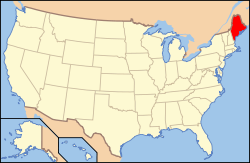
Paleontology in Maine refers to paleontological research occurring within or conducted by people from the U.S. state of Maine. The fossil record of Maine is very sparse. [1] Maine came into existence during the Ordovician as other ancient land masses accreted onto North America. At the time Maine was covered by a sea inhabited by a menagerie of invertebrates which included graptolites. During the Devonian, geologic uplift raised Maine above sea level. Early land plants flourished in the terrestrial environments. There is a gap in the local rock record spanning the remainder of the Paleozoic, the Mesozoic, and the Tertiary period of the Cenozoic era. During the Ice Age, Maine was varyingly covered by glaciers or seawater. The Devonian Pertica plant, Pertica quadrifaria , is the Maine state fossil.